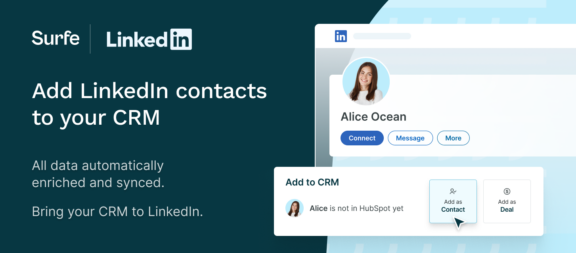How to Foster a Collaborative Environment Between Sales and Marketing

Sales and marketing teams often feel like they’re running separate races. But in reality, they’re part of the same relay. When both teams collaborate, the results can be transformative, turning fragmented efforts into a well-oiled machine that drives higher conversions, better customer experiences, and substantial revenue growth.
In fact, research shows that 79% of marketing leads never convert into sales due to lack of nurturing. So just imagine the power that your business would hold, if your teams learnt to work better together. When sales and marketing are in sync, they bridge the gap between generating leads and closing deals.
But how do we foster this collaboration in a practical, actionable way? Let’s break it down.
Need to skip ahead?
Establishing a Seamless Lead Handoff Process
The handoff between marketing and sales is a critical juncture. It’s where a marketing-generated lead either gets smoothly passed to the sales team— or falls into the dreaded void, never to be seen again. A well-defined, agreed-upon process is essential in avoiding lost leads and lost revenue.
Bridging the Gap of MQL to SQL
The journey from a Marketing Qualified Lead (MQL) to a Sales Qualified Lead (SQL) should be crystal clear to both teams. MQLs are leads that show a strong interest in your product, but they may not be ready to make a purchase just yet. SQLs, on the other hand, are vetted leads that sales can confidently pursue. Defining these categories with specific criteria—like engagement levels, company size, and fit—is essential. Both teams must be on the same page about when a lead is ready to transition.
A common mistake is to let leads languish in the middle ground, neither fully nurtured by marketing nor pursued by sales. To avoid this, establish a documented set of criteria for MQLs and SQLs. This clarity ensures that leads move seamlessly through the funnel, and no one drops the baton.
Lead Scoring and Prioritizing High-Value Leads
A robust lead-scoring system, agreed upon by both teams, allows sales to prioritize leads that are more likely to convert. Factors such as engagement level, company size, and product fit can be weighted to develop a score that determines when a lead moves from marketing to sales.
Imagine the sales team getting a daily feed of high-quality leads based on this scoring system— no more guesswork or wasted effort on leads that aren’t ready to buy. Instead, both teams can focus on the leads most likely to drive results.
Marketing’s Role in Progressing MQLs
Even the best scoring system isn’t foolproof without proper nurturing. Marketing’s job is far from over once an MQL is identified. Through content, follow-ups, and targeted campaigns, marketing can continue to engage these leads, ensuring they remain warm until they’re ready for sales engagement.
Statistics show that companies excelling in lead nurturing generate 50% more sales-ready leads at a 33% lower cost. Marketing, with its tools and strategies, can foster relationships that build trust and readiness, paving the way for sales to step in at just the right time.
Streamlining Demo Requests and Promotions
A demo request is one of the strongest indicators of buying intent. When a prospect asks for a demo, they’re often already envisioning your product as a possible solution. But generating those requests requires a combined effort from both sales and marketing.
Targeted Campaigns to Drive Demand and Generate Demos
Marketing’s role is to prime the pump with campaigns that highlight the benefits of your product and generate demand for demos. Educational content, case studies, and social proof are all powerful tools for sparking interest. With the right content and promotion strategy, marketing can create a steady stream of demo requests.
Ensuring Engagement and Follow-Up
Once a demo is requested, the sales team’s involvement is crucial. Fast, effective follow-up is key here. In fact, companies that respond within an hour are seven times more likely to have meaningful conversations. Sales should ensure that demo bookings are not only followed up on quickly but also strategically tailored to the prospect’s needs.
The All Important Close
Sales teams can’t afford to drop the ball once a demo is conducted. A structured process— from immediate follow-ups to addressing post-demo questions— should be in place to maximize conversion rates. Personalization plays a major role here, as prospects are far more likely to close when they feel understood and valued.
Making the Most of Collaboration Tools
Without shared tools, data becomes siloed, and the customer experience suffers. By implementing a unified CRM and leveraging automation tools, both teams can work smarter, not harder.
Using Your CRM as a Single Source of Truth
A shared CRM is vital for collaboration. It gives both sales and marketing visibility into the entire customer journey— from first touch to closed deal. Marketing can track which campaigns are generating high-quality leads, and sales can see how leads have interacted with content. In fact, CRMs can increase sales productivity by 34%.
This transparency ensures that no lead slips through the cracks and that both teams have access to the data they need to refine their efforts.
Surfe: Real-Time Syncing for Maximum Efficiency
Surfe helps you sync contacts, data, and interactions in your CRM in real-time, giving more visibility between sales and marketing. So both your marketing and sales functions can get immediate updates on lead progression, allowing them to collaborate on outreach strategies, nurture sequences, and deal-closing techniques without missing a beat.
Task Automation and Freeing Teams to Focus on the Work
Automation tools within CRMs can take the manual work out of lead nurturing, follow-ups, and demo scheduling. This allows both teams to focus on the more critical, high-priority tasks, such as crafting tailored responses or refining strategies. By automating repetitive tasks, you also ensure consistency and timeliness, key factors in maintaining lead engagement.

Communication and Feedback Loops
Keep Everyone on Track with Weekly Syncs and Reporting
Weekly or bi-weekly sync meetings between sales and marketing are essential for staying aligned. These meetings provide an opportunity to review lead progress, discuss upcoming campaigns, and address any challenges. Additionally, regular reporting on lead quality and campaign performance ensures that both teams stay focused on shared goals.
Real-Time Feedback
Sales can provide immediate feedback on the quality of leads generated, helping marketing to fine-tune their efforts. On the flip side, marketing can offer insights into what content or campaigns are resonating most with leads, allowing sales to adjust their pitches accordingly.
Goal Alignment
To ensure both teams are moving in the same direction, establish joint goals and KPIs. These could include metrics such as demo bookings, conversion rates from MQLs to SQLs, or overall pipeline contribution. By focusing on shared outcomes, teams become more motivated to collaborate effectively.
The Role of Content in Sales Enablement
Content as Fuel for Sales Conversations
Marketing can support the sales team with content such as case studies, white papers, and demo scripts. These assets should be backed up by data from your CRM and provide sales with the tools they need to answer common objections and nurture leads further down the funnel.
Imagine if you could give your prospect exactly the right article to address their uncertainty around the efficacy of your product, or the potential savings your service offers. With insights-driven content strategy, you can do just that.
Tailoring Content to the Buyer’s Journey
Content should also be tailored to the different stages of the buyer’s journey. By providing personalized content, such as industry-specific case studies or ROI calculators, marketing enables sales to deliver a more targeted pitch that addresses the prospect’s specific pain points.
Social Selling Support
Social selling is an increasingly important part of the sales process. Marketing can assist by creating content that sales reps can share on LinkedIn or other social platforms, allowing them to engage leads in a more informal and authentic manner.
Shared Metrics and Continuous Improvement
Tracking KPIs to Figure Out What Matters
Key metrics to track include lead conversion rates, demo-to-close ratios, and revenue contributions from both sales and marketing. A shared dashboard, available through the CRM, can provide real-time insights into these metrics, allowing both teams to make data-driven decisions.
Learning from Successes and Failures
After each major campaign, both teams should meet to review what worked and what didn’t. Using data from the CRM and other tools, they can continuously refine their strategies. This commitment to ongoing improvement ensures that both teams are always learning and evolving, so you can really deliver value to the business.
Let’s Wrap It Up!
Fostering collaboration between sales and marketing isn’t just a nice-to-have— it’s essential in driving more revenue and closing more deals. By establishing seamless processes, leveraging the right tools, and maintaining open lines of communication, sales and marketing can work together to drive better results. The reward? Higher lead conversion rates, more effective campaigns, and a unified team that’s working toward shared goals.

Want to generate more qualified leads?
Surfe’s email finder helps you verify the email addresses of your prospects, so you know your outreach will land in the right inboxes.
Frequently Asked Questions (FAQs)
Why is collaboration between sales and marketing important?
Collaboration ensures that leads are nurtured effectively, reducing wasted opportunities and improving conversion rates.
How can we ensure smooth lead handoff?
Establish clear criteria for MQLs and SQLs, and use a shared CRM to track lead progression.
What tools can help improve sales and marketing alignment?
CRMs and automation tools like Surfe can provide real-time insights and streamline collaboration.


